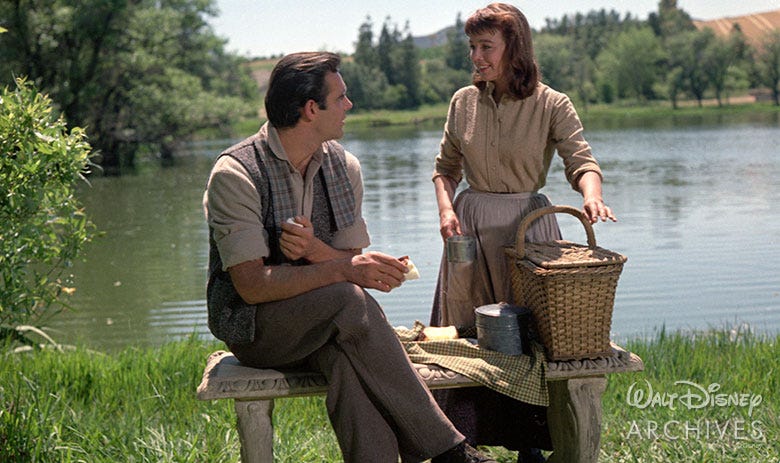PREFACE (1.)
I was five years old the first time my parents took us to the drive-in.
Or, I should say ‘parent’, singular, since mom was always looking for an excuse to be let out of family events.
It was Dad who read to us every night, took us to the movies and even on mini-vacations while mom stayed home, relishing her time away from having to watch over the care and feeding of her four children.
The movie was “Darby O’Gill and the Little People”, a Disney romantic comedy from 1959 that was rereleased a decade later, during the holiday season.
Being five, I barely remember anything about the film, except, of course the Banshee which appears in the final fifteen minutes and apparently has been the cause of many children’s nightmares.
In my memories I thought of the banshee as being bright green and as big as Godzilla with a skull face and a scythe, like a manifestation of ‘death’.
In reality, the banshee was human-sized, had no discernible face and didn’t carry a scythe, but rather what looked like a kitchen knife or small machete.
A recent rewatch (after fifty-three years) proved to be pleasant enough. Here was the lovely Janet Munro, who would later show up in another childhood favorite “The Day the Earth Caught Fire”; A toothy and leathern Sean Connery singing!; and Albert Sharpe as Darby O’Gill slurring around like an Irish Foster Brooks, portraying a ‘hilarious drunk!’ who sees leprechauns as a manifestation of his deep dipsomania.
When the banshee showed up it became clear why it had haunted me these many decades: the designers had not given it a distinct form, nothing we could hold onto.
If it had simply been a skeleton in black robes it would’ve been fairly easy to classify.
But the vague glowing mystery of the face combined with the spectral moans — like the voices of the damned — and, most of all, the inexorable, mindless hunger to bring death upon its victim — who in this case was the sweet and innocent Janet Munro — still made my heart pound all these years later.
And I suddenly remembered a nightmare from my childhood, the most vivid dream I’ve ever had, in which a creature — which I can now identify as the banshee — showed up as a glowing harbinger of doom who could turn people into wax candles by pointing a finger at them.
At the end of the dream, I managed to run around the side of the house but then I became immobile and the glow of the banshee just got brighter and brighter as it came closer to rounding the corner and getting me.
It’s hard to differentiate the grim bummer of my childhood from the visual terrors I occasionally saw at the movies.
Every so often, even now, a pall descends on me like one of those heavy vests they put on you at the dentist. An indefinable, free-floating anxiety that I’ve only recently identified — through a decade of therapy — as the default vibe of my childhood.
This vibe: a thick, oily dread that began each morning and stayed throughout the day, manifested in my body as a kind of jittery anticipation, the sense that things were just about to go awry. That a door would suddenly open and a jack-in-the-box horror would grab hold of me and drag me away.
Part of this was, unfortunately, the presence of my mother, who, like the banshee, seemed to want to reach out and bring, perhaps not literal death, but a hopeless misery that was, at times, a kind of living death.
The sad truth is that I spent most of my childhood in abject terror of my mother.
The sound of her car pulling into the driveway; the heavy tread of her heels pounding down the hardwood floor of the hallway; the banshee-like way she’d scream my name, standing on the front porch; a sound that could reach me no matter where I was in the neighborhood and snap me instantly out of whatever escapist pleasures I was involved in and transport me back to the realities of my home life.
In “Something Evil:, a Steven Spielberg TV movie from 1972 - which I saw at home when I was seven years old - Sandy Dennis plays an abusive mom who, at one point, chases her son (played by Johnny Whitaker) around, screaming his name and beating the crap out of him.
The son’s name was “Stephen”, which is also my real first name. (Part of the reason I took my middle name, Justin, was because of the traumatizing echoes of hearing the name “Stephen” screamed aloud by my mother).
Hearing Sandy Dennis — who, like my mother, was kind of a hippy, making DIY crafts and having parties where everybody got drunk — shouting MY name and beating Jonny Whitaker while he yelled “Mommy, no!”, shocked me like an electric current.
The brilliance of that early Spielberg work was using the metaphor of devil possession as a way to talk about child abuse. And if you want to look through a window into what my early life felt like, watch “Something Evil.”
It’s a time machine into the long, twisted, dread-filled afternoons of my childhood.








Wow. Thank you for your candor and insight. This must be hard to relive, and hard to write about. Kudos to you for sharing!